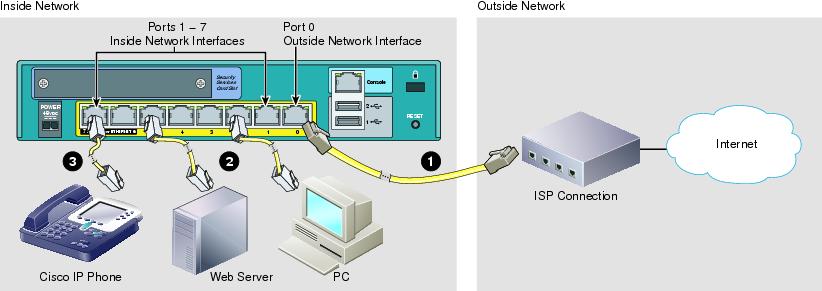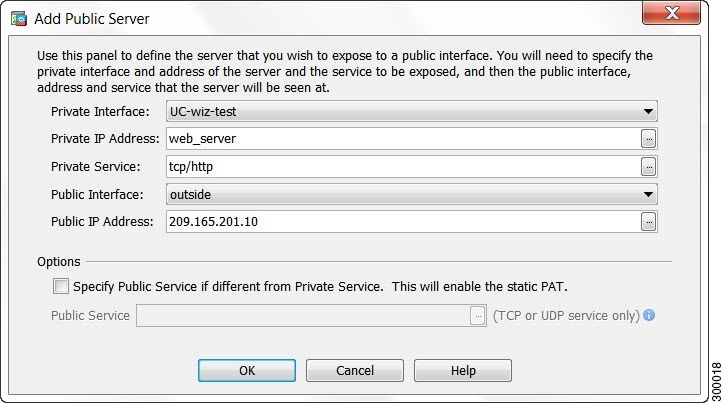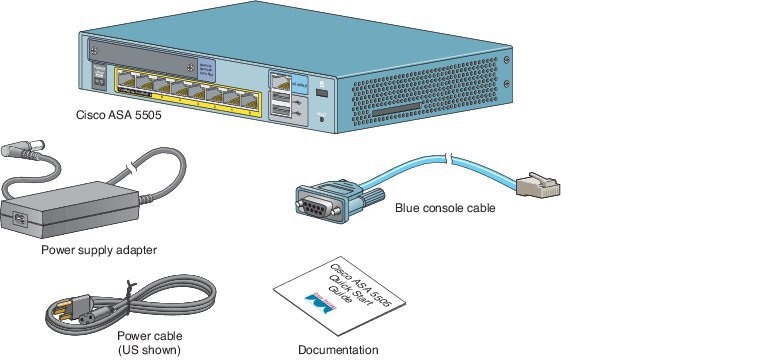Cisco ASA 5505 Quick Start Guide
Available Languages
Table of Contents
1. Verifying the Package Contents
3. Powering on and Verifying Interface Connectivity
4. Initial Configuration Considerations
7. (Optional) Allowing Access to Public Servers Behind the ASA
8. (Optional) Running VPN Wizards

Note![]() Read the safety warnings in the Regulatory Compliance and Safety Information (RCSI), and follow proper safety procedures when performing the steps in this guide. See http://www.cisco.com/go/asadocs for links to the RCSI and other documents.
Read the safety warnings in the Regulatory Compliance and Safety Information (RCSI), and follow proper safety procedures when performing the steps in this guide. See http://www.cisco.com/go/asadocs for links to the RCSI and other documents.
2. Installing the Chassis
The ASA ships with a default configuration that includes two preconfigured networks (the Inside network and the Outside network) and an Inside interface configured for a DHCP server. Clients on the Inside network obtain a dynamic IP address from the ASA so that they can communicate with each other as well as with devices on the Internet.
Step 1![]() Connect one end of an Ethernet cable (not provided) to Ethernet 0 on the ASA. (By default, Ethernet 0 is the Outside interface.) Connect the other end to a cable/DSL modem or gateway router (the Outside network).
Connect one end of an Ethernet cable (not provided) to Ethernet 0 on the ASA. (By default, Ethernet 0 is the Outside interface.) Connect the other end to a cable/DSL modem or gateway router (the Outside network).
Step 2![]() Connect your devices (such as PCs, printers, and servers) with Ethernet cables to Ethernet 1 through 7.
Connect your devices (such as PCs, printers, and servers) with Ethernet cables to Ethernet 1 through 7.

Note![]() Connect a PC to the ASA so that you can run the Adaptive Security Device Manager (ASDM). See “4. Initial Configuration Considerations.”
Connect a PC to the ASA so that you can run the Adaptive Security Device Manager (ASDM). See “4. Initial Configuration Considerations.”
Step 3![]() Connect Power over Ethernet (PoE) devices (such as Cisco IP Phones or network cameras) with Ethernet cables to switch ports 6 or 7 (the only ports providing power to PoE devices).
Connect Power over Ethernet (PoE) devices (such as Cisco IP Phones or network cameras) with Ethernet cables to switch ports 6 or 7 (the only ports providing power to PoE devices).

If you connect a server (such as a web server) to the ASA, you can use ASDM to make services on that server accessible by internal and external users. See “7. (Optional) Allowing Access to Public Servers Behind the ASA.”
3. Powering on and Verifying Interface Connectivity
Step 1![]() Connect the power supply adaptor to the power cable.
Connect the power supply adaptor to the power cable.
Step 2![]() Connect the rectangular connector of the power supply adaptor to the power connector on the rear panel of the ASA.
Connect the rectangular connector of the power supply adaptor to the power connector on the rear panel of the ASA.
Step 3![]() Connect the AC power connector of the power cable to an electrical outlet. (The ASA does not have a power switch. Completing this step powers on the device.)
Connect the AC power connector of the power cable to an electrical outlet. (The ASA does not have a power switch. Completing this step powers on the device.)
Step 4![]() Check the Power LED on the front of the ASA; if it is solid green, the device is powered on.
Check the Power LED on the front of the ASA; if it is solid green, the device is powered on.
Step 5![]() Check your management PC to make sure it received an IP address on the 192.168.1.0/24 network using DHCP.
Check your management PC to make sure it received an IP address on the 192.168.1.0/24 network using DHCP.
Step 6![]() Check the LINK/ACT indicators to verify interface connectivity.
Check the LINK/ACT indicators to verify interface connectivity.
Interface Connectivity
Each Ethernet interface has an LED to indicate a physical link is established. When the LED is solid green, a link is established. When the LED is flashing green, there is network activity.

If a LINK/ACT LED is not lit, the link could be down due to a duplex mismatch. If auto-negotiation is disabled, verify you are using a straight-through Ethernet cable.
For a description of all chassis components, see the hardware installation guide on Cisco.com.
4. Initial Configuration Considerations
The ASA ships with a default configuration that, in most cases, is sufficient for your basic deployment. You configure the ASA by using ASDM. ASDM is a graphical interface that allows you to manage the ASA from any location by using a web browser.
However, changing certain settings is recommended or required. For example, you should change the following settings from their defaults:
- The privileged EXEC mode (enable) password that is required to administer the ASA through ASDM and the CLI
- When using the ASA as a VPN endpoint (using the SSL VPN features):
–![]() The hostname, domain name, and DNS server names
The hostname, domain name, and DNS server names
–![]() Outside interface IP address to a static address
Outside interface IP address to a static address
–![]() WINS names when access to Windows file shares is required
WINS names when access to Windows file shares is required
Use the Startup Wizard in ASDM to make these changes. See “6. Running the Startup Wizard.”
5. Launching ASDM
See the ASDM release notes on Cisco.com for the requirements to run ASDM.
Step 1![]() On the PC connected to the ASA, launch a web browser.
On the PC connected to the ASA, launch a web browser.
Step 2![]() In the Address field, enter the following URL:
In the Address field, enter the following URL:
The Cisco ASDM web page appears.

Step 3![]() Click Run Startup Wizard.
Click Run Startup Wizard.
Step 4![]() Accept any certificates according to the dialog boxes that appear. The Cisco ASDM-IDM Launcher appears.
Accept any certificates according to the dialog boxes that appear. The Cisco ASDM-IDM Launcher appears.
Step 5![]() Leave the username and password fields empty and click OK.
Leave the username and password fields empty and click OK.
The main ASDM window appears and the Startup Wizard opens. See “6. Running the Startup Wizard.”
6. Running the Startup Wizard
Run the Startup Wizard to modify the default configuration so that you can customize the security policy to suit your deployment. Using the startup wizard, you can set the following:

Step 1![]() If the wizard is not already running, in the main ASDM window, choose Wizards > Startup Wizard.
If the wizard is not already running, in the main ASDM window, choose Wizards > Startup Wizard.
Step 2![]() Follow the instructions in the Startup Wizard to configure your ASA.
Follow the instructions in the Startup Wizard to configure your ASA.
Step 3![]() While running the wizard, you can accept the default settings or change them as required. (For information about any wizard field, click Help.)
While running the wizard, you can accept the default settings or change them as required. (For information about any wizard field, click Help.)
7. (Optional) Allowing Access to Public Servers Behind the ASA
The Public Server pane automatically configures the security policy to make an inside server accessible from the Internet. As a business owner, you might have internal network services, such as a web and FTP server, that need to be available to an outside user. You can place these services on a separate network behind the ASA, called a demilitarized zone (DMZ). By placing the public servers on the DMZ, any attacks launched against the public servers do not affect your inside networks.

Step 1![]() In the main ASDM window, choose Configuration > Firewall > Public Servers. The Public Server pane appears.
In the main ASDM window, choose Configuration > Firewall > Public Servers. The Public Server pane appears.
Step 2![]() Click Add, then enter the public server settings in the Add Public Server dialog box. (For information about any field, click Help.)
Click Add, then enter the public server settings in the Add Public Server dialog box. (For information about any field, click Help.)
Step 3![]() Click OK. The server appears in the list.
Click OK. The server appears in the list.
Step 4![]() Click Apply to submit the configuration to the ASA.
Click Apply to submit the configuration to the ASA.
8. (Optional) Running VPN Wizards
You can configure VPN using the following wizards:
- Site-to-Site VPN Wizard—Creates an IPsec site-to-site tunnel between two ASAs.
- AnyConnect VPN Wizard—Configures SSL VPN remote access for the Cisco AnyConnect VPN client. AnyConnect provides secure SSL connections to the ASA for remote users with full VPN tunneling to corporate resources. The ASA policy can be configured to download the AnyConnect Client to remote users when they initially connect via a browser. With AnyConnect 3.0 and later, the client can run either the SSL or IPSec IKEv2 VPN protocol.
- Clientless SSL VPN Wizard—Configures clientless SSL VPN remote access for a browser. Clientless, browser-based SSL VPN lets users establish a secure, remote-access VPN tunnel to the ASA using a web browser. After authentication, users access a portal page and can access specific, supported internal resources. The network administrator provides access to resources by users on a group basis. ACLs can be applied to restrict or allow access to specific corporate resources.
- IPsec (IKEv1) Remote Access VPN Wizard—Configures IPsec VPN remote access for the Cisco IPsec client.

Step 1![]() In the main ASDM window, choose Wizards > VPN Wizards, then choose one of the following:
In the main ASDM window, choose Wizards > VPN Wizards, then choose one of the following:
Step 2![]() Follow the wizard instructions. (For information about any wizard field, click Help.)
Follow the wizard instructions. (For information about any wizard field, click Help.)
Contact Cisco
- Open a Support Case

- (Requires a Cisco Service Contract)

 Feedback
Feedback